How To Make Rose Water
This post may contain affiliate links. Read disclosure policy.
Rose water is a simple, natural, and lovely addition to more than just your skincare routine. Learn how to make rose water with a simple process and two natural ingredients, then enjoy this new multi-purpose household favorite!
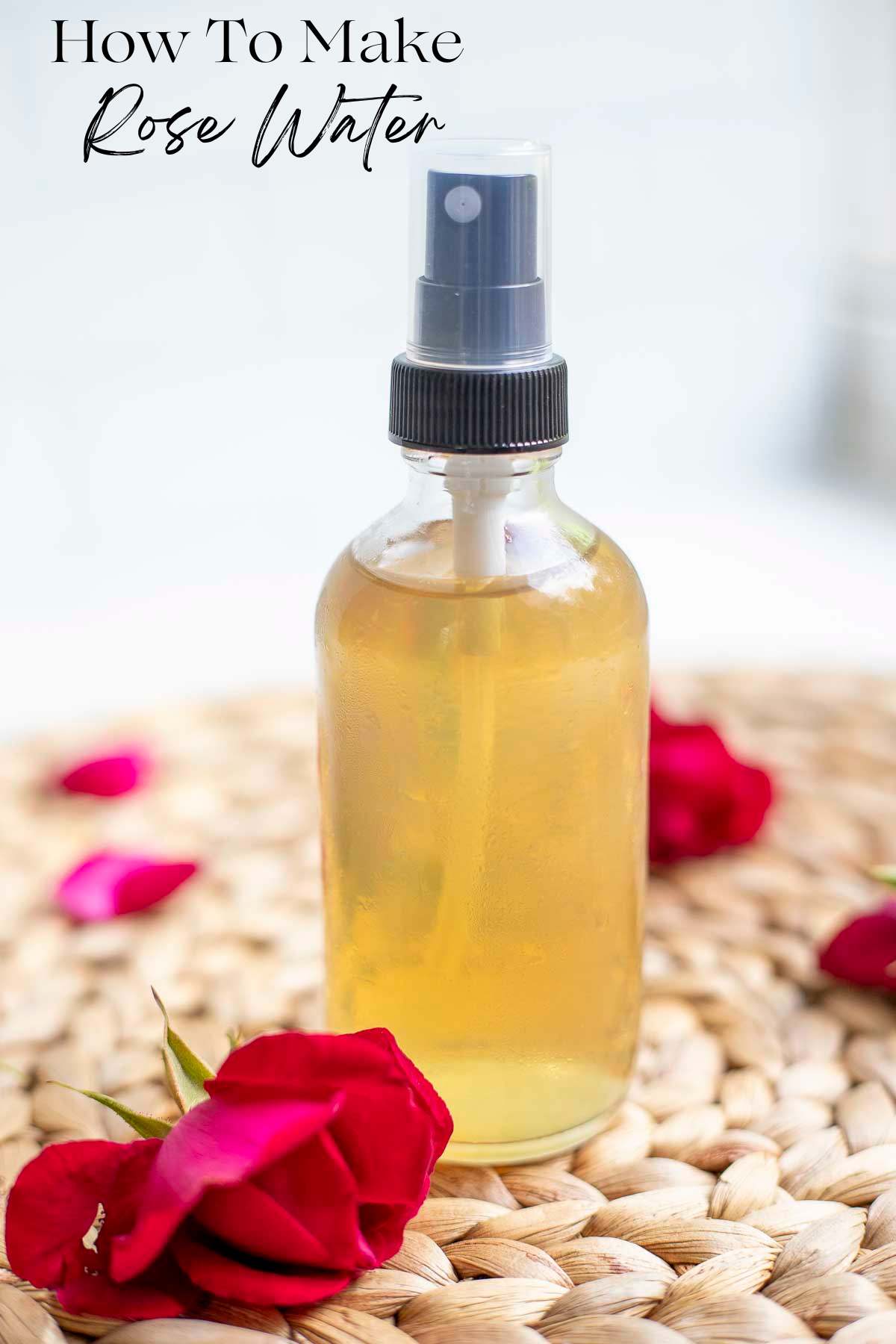
Clearly roses are a popular flower, being both fragrant and beautiful. They are the national flower of the United States after all. They can be used for many homemade products, my favorite is homemade herbal toner or face wash.
But did you realize that roses are edible? Some varieties will naturally taste better than others, but all varieties can be consumed.
It’s been said before that the better the rose smells, the better it will taste. On the same note, a stronger scent generally indicates a bolder flavor.
And at the end of summer, you may notice that the roses in your yard or nearby woods lose their petals and reveal dark-colored, orange-red berries.
These berries are known as rosehips, the fruit of the rose bush, also edible and rich in vitamin C. They are often eaten raw, but can also be made into jams and jellies, syrups, powders, and even added to herbal tea (like this rosemary tea)
The rose is not only beautiful but so useful as well!
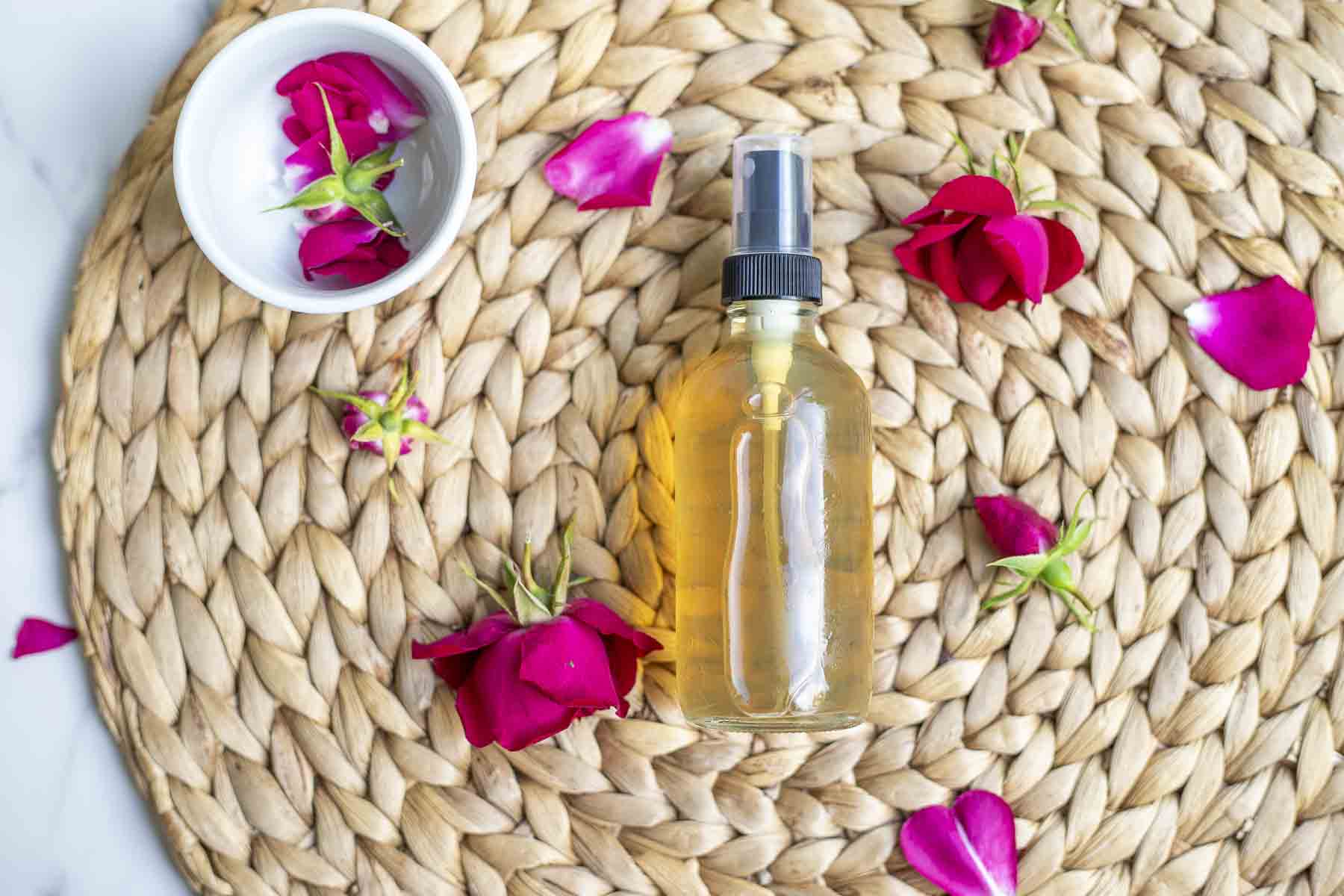
Benefits of Rose Water
Rose water is a simple, but incredibly useful concoction with many uses around the home.
Skincare
- Working as a natural toner, rose water soothes your skin and can reduce redness.
- It’s a wonderful cleanser, deep cleaning pores and even reducing the appearance of wrinkles and fine lines.
- It can be applied to your entire face, including lips, to add moisture and soften the skin. It can even help to lessen dark circles or puffy eyes by applying with a cotton pad before going to sleep.
- It’s recommended that you apply rose water before other moisturizers, oils, or creams.
Body spray
Far superior to synthetic fragrance, homemade rose water is made from natural ingredients, and the rose blossoms exude a sweet smell that is not overpowering. It’s helpful for those who are sensitive to perfumes and other strong aromas.
Room spray
Better than candles or air fresheners with synthetic fragrances, this all-natural spray can be spritzed around the home to refresh furniture, bedding, carpeting, and closets. Aromatherapy doesn’t get any better! Or try this homemade air freshener spray.
Hair care
Rose water moisturizes the scalp and hair, smoothing, reducing frizziness, and helping to detangle. Apply to damp hair before drying and styling, as it can help to protect follicles from heat and products.
Medicinal purposes
Rose water has anti-inflammatory properties, contains anti-oxidants, and is rich in vitamins A, E, C, D, and B.
Add rose water to hot tea or sip it on its own to soothe sore throats and nagging coughs, while also hydrating with the benefits of vitamins and minerals.
Rose water is known to be useful as an eye drop for conjunctivitis and other eye issues, as well as helping clean and treat wounds and infections, and improving mood and sleep. (source)
Other uses
It can also be added to homemade soaps, household cleaners, or a relaxing bath. You can even add it to your fresh lemonade, iced tea, or water.
Keep in Mind:
As with all things, be watchful for any allergic reaction – burning, redness, stinging, etc. If applying topically, test a small area of skin before applying it all over.
What Kinds of Roses Should You Use?
Any type of rose will work for making your own rose water, though some are more potent than others.
Some of the best and most commonly used are the rosa gallica, rosa damascena, and the rosa centifolia (also known as a cabbage rose). These varieties are all edible and some of the most fragrant roses.
Whatever type you use, be sure they are pesticide-free roses.
A great option is to use homegrown roses or even wild roses. As long as they are not in a location that is sprayed for weeds, they will be fine to use.
This is a great opportunity for those with flower gardens or wild roses growing around their property!
Fresh or dried rose petals?
Either fresh or dried petals will work for this recipe!
If using dried petals, the conversion is as follows: one cup of fresh rose petals = 1/4 cup of dried rose petals.
If you have an abundance of roses and want to preserve them for future recipes, you can air-dry them, use a dehydrator, or even bake them at a low temperature in the oven. Check out this article on drying rose petals.
Fresh rose petals, however, are easy and no wait. You can make rose water and then toss some fresh petals in your salad at lunch. See? So versatile.
Methods
There are two methods for making rose water: simmering and distillation. Simmering is quicker, but distillation creates a longer-lasting product.
Save This Recipe
Both methods can be successfully completed in your own kitchen with minimal tools and ingredients.
Tools
Saucepan with lid
Small glass bowl
Funnel
Ingredients
Simmering Method
Rose petals – fresh petals or dried
Distilled water – filtered works if you don’t have distilled.
Vodka – optional, approximately 1 ounce per 2 cups of water
Distillation Method
Rose petals – fresh or dried
Distilled water – filtered works if you don’t have distilled
Ice
How to Make DIY Rose Water

Simmering Method

Step 1: Pull petals from the stems, and place them in a colander. Rinse with cool water letting them drain as much as possible.

Step 2: Add the cleaned rose petals to a large saucepan.
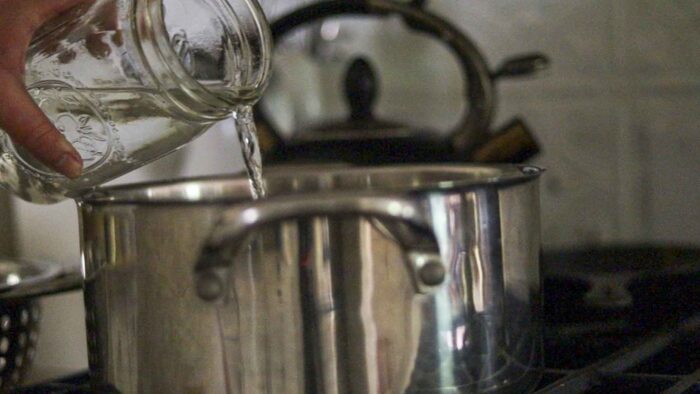
Step 3: Add enough water to just cover the rose petals. Too much water will yield a weaker product. Bring the water to a simmer, not a boil. Cover with a lid to trap any moisture inside, then simmer for 30-40 minutes or until the color of the petals has gone out of them.

Step 4: Remove from the heat and let the water cool to room temperature. If preserving longer than 2 weeks, add vodka at this step.
Strain from the saucepan into a glass jar or bottle using a funnel.
Distillation Method
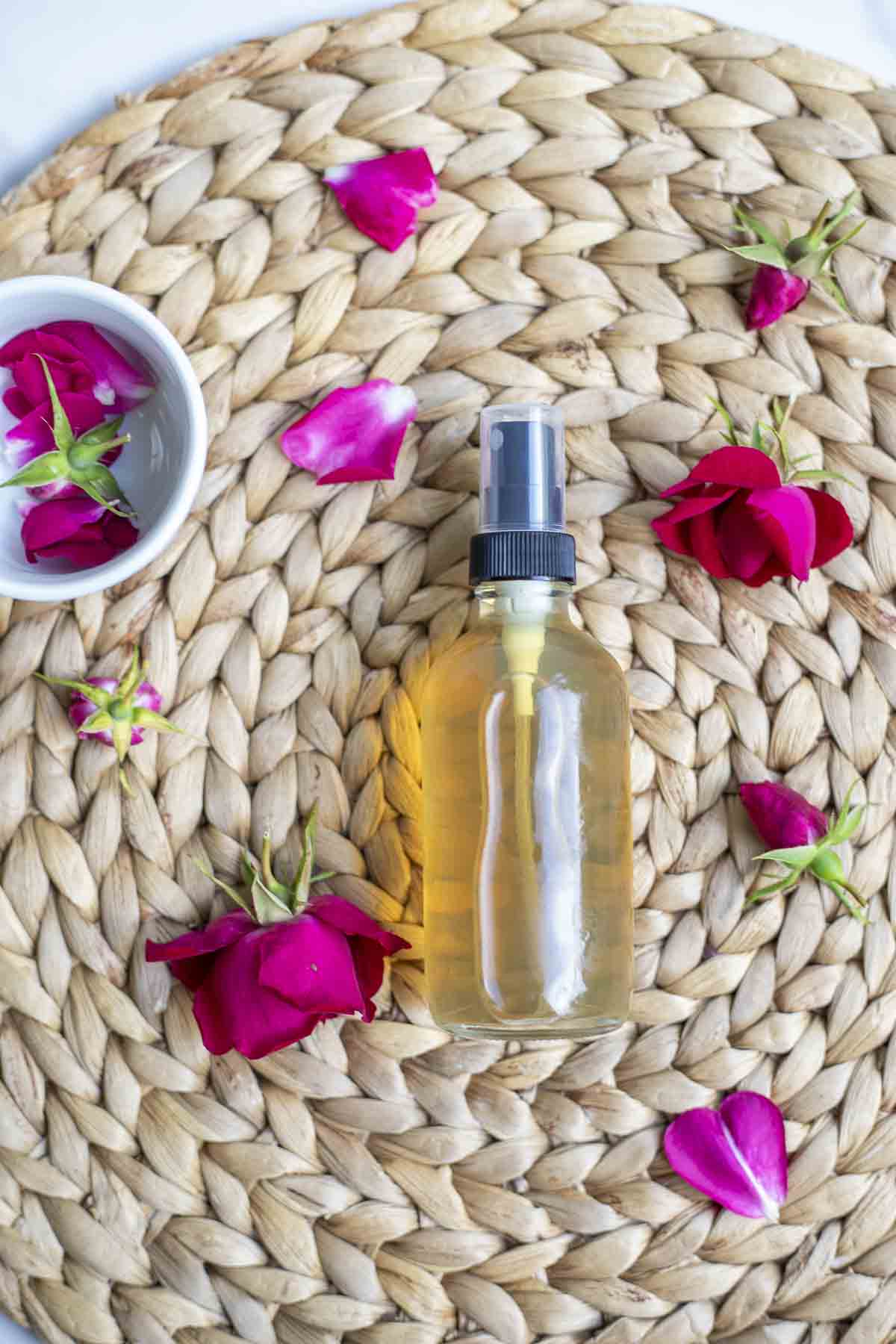
Begin with two to three cups of loose, fresh, clean rose petals (or 1/2 to 3/4 cup of dried).
Place a small bowl into the center of your saucepan, then add the rose petals around it.
Cover the petals with water, but do not exceed the top of the glass bowl.
Cover with your lid upside-down. This allows the condensation to build, then be directed to the center of the lid, down the handle, and into the bowl at the bottom.
Heat the water to a simmer, not a boil.
Place ice cubes on the lid to foster condensation, and as the ice melts, keep adding more.
Simmer for approximately 30 minutes or until the color of the petals has gone out of them.
Remove from heat and cool to room temperature. If desired, add vodka at this step.
Strain and pour into your jar or bottle using a funnel.
Storage
Keep homemade rose water refrigerated or in a cool, dark place to conserve its potency. Monitor for any sour smell or cloudy appearance that would suggest the rose water has gone bad.
Rose water made via the simmering method will last up to two weeks, while the distilled method generally yields a product that lasts a longer time — six months or more.
FAQ
Yes! All varieties of rose are edible, so rose water may be ingested on its own, as well as in drinks like rose tea or flavored lemonade.
The answer is yes! It contains vitamins and antioxidants, has been shown to improve digestion, relieve bloating, and even calm an upset stomach. (source)
It could be because you have boiled the water rather than simmered. But I have made rose water multiple times with pink and red roses and have never gotten it to turn pink.
More natural, homemade products from A Blossoming Life:
- Natural DIY Hair Spray
- Homemade Dry Shampoo
- Homemade Face Wash
- Natural Glass Cleaner
- Homemade Bubble Bath
- Dandelion Oil
Tried this recipe and loved it? I would love if you would come back and give it 5 stars. Please and thank you! Tag me on Instagram @ablossominglife
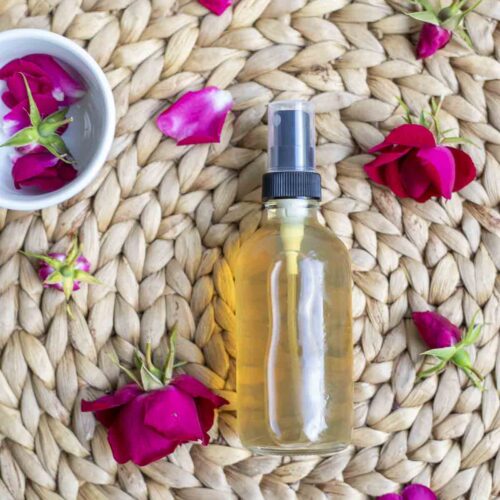
Rose Water
Save This Recipe
Equipment
- Strainer
- Saucepan
Ingredients
- 2 cups fresh rose petals or 1/2 cup dried
- 2 cups water distilled or filtered.
Instructions
Simmering Method
- Beginning with two to three cups of loose, fresh, clean rose petals (or 1/2 to 3/4 cup of dried), add them to a large saucepan.
- Add enough water to just cover the rose petals. Too much water will yield a weaker product.
- Bring the water to a simmer, not a boil.
- Cover with a lid to trap any moisture inside, then simmer for 30-40 minutes or until the color of the petals has gone out of them.
- Remove from the heat and let the water cool to room temperature. If preserving longer than 2 weeks, add vodka at this step.
- Strain from the saucepan into a glass jar or bottle using a funnel.
Distillation Method
- Begin with two to three cups of loose, fresh, clean rose petals (or 1/2 to 3/4 cup of dried).
- Place a small bowl into the center of your saucepan, then add the rose petals around it.
- Cover the petals with water, but do not exceed the top of the glass bowl.
- Cover with your lid upside-down. This allows the condensation to build, then be directed to the center of the lid, down the handle, and into the bowl at the bottom.
- Heat the water to a simmer, not a boil.
- Place ice cubes on the lid to foster condensation, and as the ice melts, keep adding more.
- Simmer for approximately 30 minutes or until the color of the petals has gone out of them.
- Remove from heat and cool to room temperature. If desired, add vodka at this step.
- Strain and pour into your jar or bottle using a funnel.

